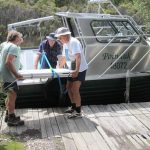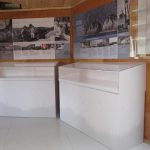When Community Groups Work Together A MUSEUM TAKES SHAPE AT MELALEUCA
No museum is complete without objects; they show what life was like in some past time. Hand-made treasures or ordinary work-a-day tools can round out a story told with print and photos, while close-up, objects from the natural world can give a deeper understanding of the local environment. But these objects must be protected as well as displayed in an attractive, informative way to be meaningful to the audience. Challenging enough, but even more so when transport is by boat or light aircraft. Members of Friends of Melaleuca pondered the question of display cases and how to get them to Melaleuca. Glass might break in transit; ready-made cases were the wrong size for the space and too heavy – no fork-lift at Melaleuca! Roger Walker, a member of both Friends of Melaleuca and the Channel Men’s Shed came up with a solution. He put the two groups in touch.
FoM put a proposal to the Channel Men’s Shed, who generously agreed to build custom-designed display cabinets for the cost of the materials. Geoff Fenton designed the cabinets to be ‘knock-down’ so that they could be flat-packed in the bottom of the boat’s hold. Reuben Sternberg from the Channel Men’s Shed drew them in ‘Sketch-up’, a computer drafting program, and built them from plywood to withstand the damp atmosphere at Melaleuca. We were very impressed with Reuben’s professional accuracy and speedy work. The cabinets were ready in no time, and came back to our place at Longley for a coat of paint. Acrylic lids were fabricated by Associated Plastics in Moonah, who also made us four
custom-designed wall-cases for smaller objects.
This project was enabled by a grant from the Tasmanian Community Fund. This independent community funding body was established following the sale of the Trust Bank in 1999 to give back to the community proceeds from the sale of a community asset. Since that time the TCF has allocated approximately $59 million to approximately 1700 projects state-wide.
Cabinets, wall-cases and printed display panels for the Deny King Heritage Museum were transported to Melaleuca by boat. Once there, the cabinets were assembled and volunteers gave them further coats of paint, the finishing touch being a painted tonal mural of buttongrass on the front of each cabinet.
They were installed in January, and objects have been arranged in two so far.
Work on this will continue during FoM’s annual working bee in March 2017.
Rewardingly, the many visitors to Melaleuca have shown engagement and expressed appreciation of our project.
Janet Fenton


